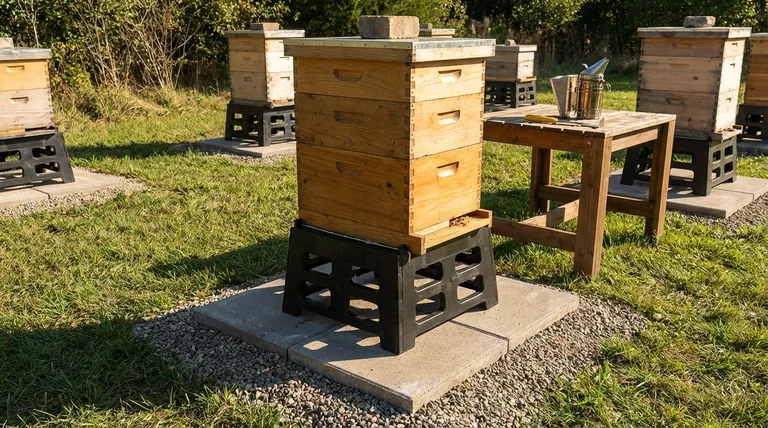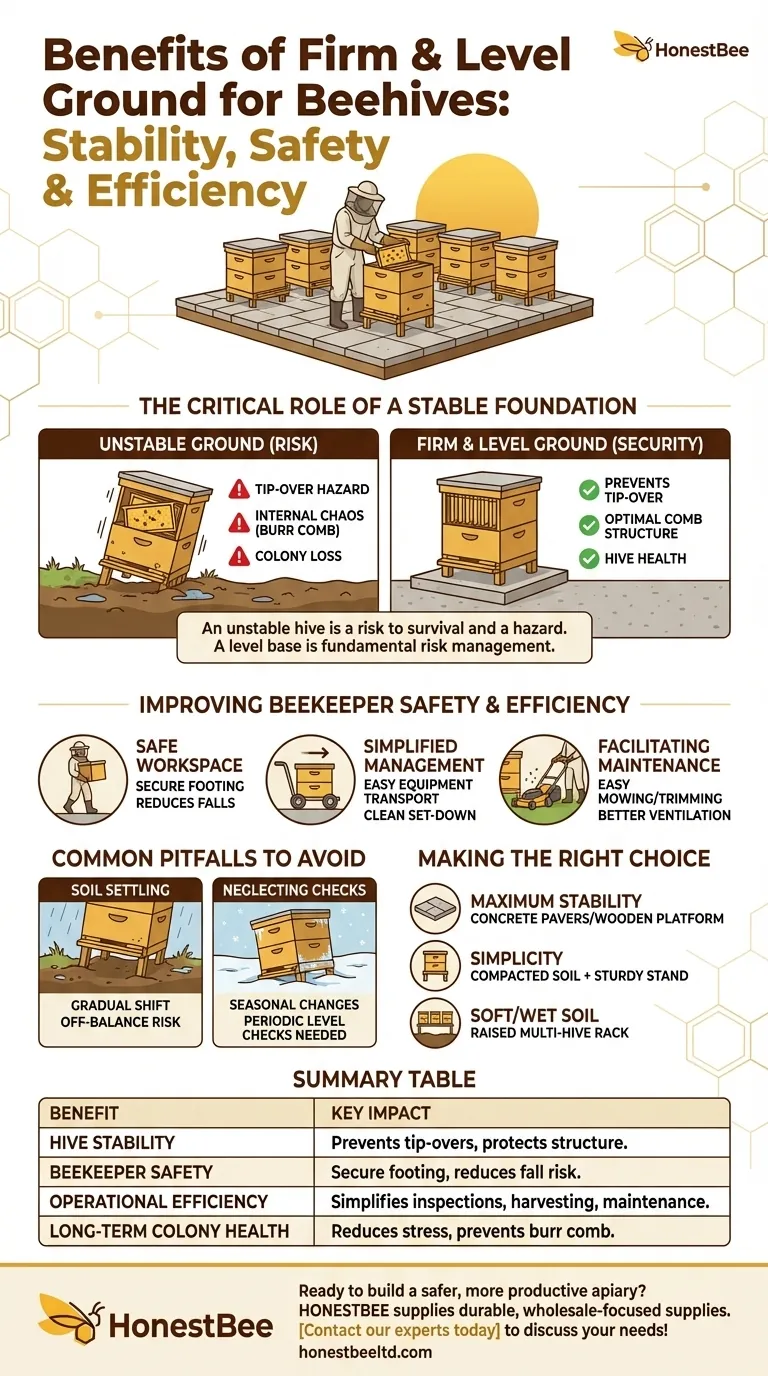The primary benefits of firm and level ground for beehives are twofold: it ensures the physical stability of the hive itself and simplifies access and maintenance for the beekeeper. A proper foundation prevents catastrophic hive failures from tipping over and makes routine inspections significantly safer and more efficient.
An unstable hive is a risk to the colony's survival and a hazard for the beekeeper. Investing time in creating a firm, level foundation is a fundamental act of risk management that pays dividends in hive health and operational safety.

The Critical Role of a Stable Foundation
A hive is a heavy, vertical structure that becomes top-heavy when full of honey. The stability of its base is not a minor detail; it's essential for the colony's well-being.
Preventing a Catastrophic Tip-Over
A hive that is not on stable, level ground is vulnerable. Soggy soil, uneven terrain, or even a weak hive stand can lead to the entire hive toppling over.
This event is often fatal for the colony. The queen can be crushed, frames of brood are destroyed, and the resulting chaos can cause the remaining bees to abandon the hive entirely.
Protecting the Internal Colony Structure
Bees build their honeycomb straight down, guided by gravity. When a hive is perfectly level, the frames hang correctly, and the bees build comb within these designated spaces.
If a hive is tilted, bees may build "burr comb" that connects adjacent frames or attaches them to the hive walls. This makes inspections difficult, messy, and risks damaging the comb or harming bees.
Improving Beekeeper Safety and Efficiency
The beekeeper's ability to work safely and effectively around the hives is directly impacted by the ground conditions of the apiary.
Creating a Safe Workspace
A beekeeper often carries heavy hive boxes (supers) that can weigh over 50 pounds. Stumbling on uneven ground while carrying this weight is a significant safety hazard.
Firm, level ground provides a secure footing, drastically reducing the risk of trips and falls during hive inspections or honey harvesting.
Simplifying Hive Management
Routine work is much easier in a well-prepared bee yard. Level ground allows for the easy use of equipment like hive carts or wheelbarrows to transport heavy supers.
It also provides a clean and stable place to set down hive components, like the roof or inner cover, during an inspection.
Facilitating Yard Maintenance
Keeping the area around the hive clear of grass and weeds is crucial for ventilation and pest control. A firm, clear base makes it much easier to mow or trim around the hives without disturbing the bees.
Common Pitfalls to Avoid
Simply placing a hive stand on cleared dirt is a common but often flawed approach. Understanding the potential issues can prevent future problems.
Overlooking Soil Compaction and Settling
Loose soil, even when raked level, will settle over time. Heavy rains can turn the ground soft and cause the hive stand's legs to sink unevenly.
This gradual shift can leave a hive dangerously off-balance without the beekeeper noticing until it's too late. The goal is a firm base, not just a temporarily level one.
Neglecting Ongoing Checks
Ground conditions are not static. Frost heave in the winter, erosion from rain, or even animal activity can alter the ground under a hive.
It is good practice to periodically check your hives with a small level, especially after major weather events or at the start of a new season.
Making the Right Choice for Your Apiary
Your approach can be tailored to your environment and goals.
- If your primary focus is maximum stability and longevity: Use concrete paving stones or build a permanent wooden platform to create an undeniably firm and level base.
- If your primary focus is simplicity in a stable location: Ensure the ground is compacted and use a sturdy hive stand, checking it for levelness a few times per year.
- If you are in an area with very soft or wet soil: Build a raised, multi-hive rack that distributes the weight over a larger area and elevates the hives above the damp ground entirely.
A solid foundation for your hives is the first step toward a safer, healthier, and more productive beekeeping experience.
Summary Table:
| Benefit | Key Impact |
|---|---|
| Hive Stability | Prevents catastrophic tip-overs and protects the internal colony structure. |
| Beekeeper Safety | Provides secure footing, reducing the risk of trips and falls during heavy lifting. |
| Operational Efficiency | Simplifies inspections, honey harvesting, and yard maintenance. |
| Long-Term Colony Health | Reduces stress on bees and prevents messy burr comb from forming. |
Ready to build a safer, more productive apiary? The right foundation starts with the right equipment. At HONESTBEE, we supply commercial apiaries and beekeeping equipment distributors with the durable, wholesale-focused supplies needed to create stable, long-lasting hive setups. Let us help you protect your investment and your bees. Contact our experts today to discuss your apiary's needs!
Visual Guide

Related Products
- Plastic Bee Hive Stand for Beekeeping
- Professional Engraved Round Hive Number Tags for Beekeeping
- Professional Ant-Proof Beehive Stand with Integrated Moat for Beekeeping
- Metal Hive Feet Bee Hive Stand for Ant Protection
- Metal Bee Hive Stand Bee Box Stand for Beekeeping
People Also Ask
- Why is it important to level a hive stand properly? Prevent Catastrophic Failure & Ensure Hive Health
- How do bees regulate ventilation and temperature in the hive? Master Hive Climate Control
- What are the advantages of polystyrene hives for beekeeping? Boost Colony Health & Honey Yields
- How do bees regulate the temperature of their hive during the summer? Discover Their Natural Cooling System
- How do plastic bee hives compare to wooden hives in handling? Reduce Strain & Boost Efficiency



















